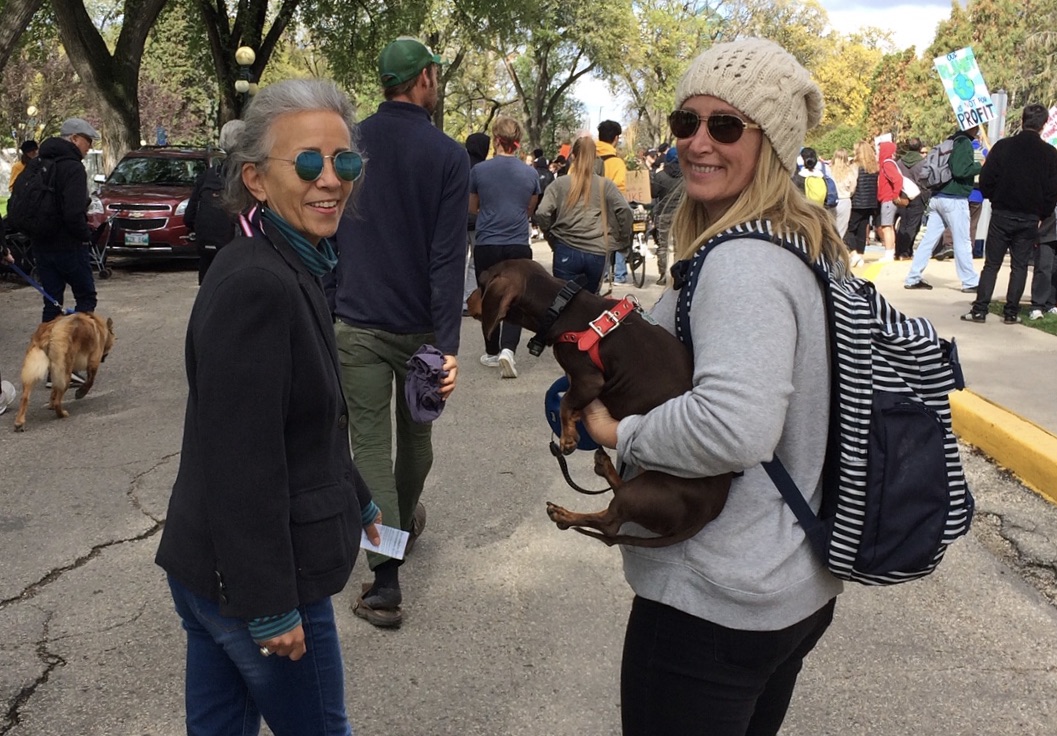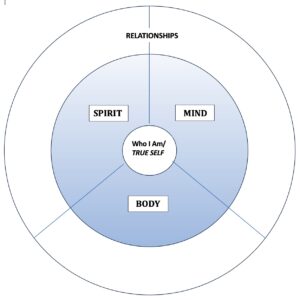As I walked and chanted with thousands to bring awareness to the need for climate action, protest signs all around me were a constant reminder of how vital a clean planet and clean air are. Breath is life.
Although many life-sustaining practices, particularly in the western world, emphasize physical movement, flexibility and strength, the purpose of yoga’s asanas (poses) is to create the capacity necessary to manage prana flow. This vital life force animates all five koshas (layers of our being) enabling the body to move, the senses to feel, the mind to think and our higher selves to manifest. In yoga, these movements or functions of prana are described as “winds” (vayus). The five vayus, as depicted below, govern different aspects of our physical and subtle being.
| VAYU | AREA OF BODY | FUNCTION |
| Apana | Pelvis | Governs elimination; downward & outward moving energy |
| Samana | Navel | Governs assimilation, discernment, inner absorption, consolidation; middle energy |
| Prana | Chest, head | Governs intake, inspiration, propulsion; inward & upward moving energy |
| Udana | Throat | Governs growth, speech, expression, ascension; upward moving energy |
| Vyana | Whole body | Governs circulation on all levels, expansiveness, pervasiveness; core to periphery |
Source: Sandra Anderson- Apana Vayu. As an eliminating force (excretion, urination, menstruation), apana vayu roots and grounds us in the pelvis. It forms a solid foundation for conserving and redirecting apana via mula bandha (the root lock) in order to effortlessly access deeper layers of each asana as well as deeper states of awareness.
To stabilize and energize apana, activate the mula bandha in each of the following poses — prasarita padottanasana, vrksasana, ardha padma janu sirsasana, baddha konasana, salabhasana (full locust).
- Samana Vayu. As an assimilating force, samana vayu collects absorbed energy from various inputs (breath, senses, food, experiences) and processes that energy to maximize digestion and vitality. Samana is the hub of pranic energy. Asanas draw downward-moving apana and upward-moving prana into this navel centre for integration, which awakens the sushumna nadi so absorption of the mind (samadhi) can be realized.
To stoke the transformative fire of samana, asanas such as forward bends, twists and abdominal strengtheners awaken and activate this navel centre — parivritta parsvakonasana, utkatasana, jathara parivartanasana, salabhasana, marichyasana, paschimottanasana. These asanas also cultivate our capacity for uddiyana bandha (upward flying lock) to bring apana vayu toward the navel centre into prana vayu.
Uddiyana bandha is the lion which conquers the elephant, death.
Hatha Yoga Pradipika
- Prana Vayu. As an energizing wind or force, prana vayu governs respiration and reception — air, food, impressions, ideas. Its inward movement finds its home in the heart and lungs and heightens our external senses and inner awareness. When prana vayu is balanced, our outlook is positive and our inner view content.
To enhance prana vayu functionality, open the body with deep breathing and boost energy and confidence through the following asanas — adho mukha svanasana, plank, urdhva mukha svanasana, gomukhasana, parivritta janu sirsasana.
- Udana Vayu. As an ascending breath or force, udana vayu lifts pranic flow from lower to higher states of consciousness. Udana moves through sushumna nadi (central channel of the subtle body) and is thus associated with the creative consciousness of enlightenment. Ruling the throat chakra, udana brings articulate, joyous speech when in balance. When out of balance, speech becomes negative, excessive or non-existent.
To enliven udana, practice well-balanced asana sequences, which tap into apana, prana and samana vayus, and finish with deep relaxation and meditation. Inversions and asanas that move energy into the head, neck and upper back activate udana. When done toward the end of a practice, these poses (see below) are further enhanced by the improved alignment and functioning gained from the earlier portion — setu bandha sarvangasana (knees bent or straight), Viparita Karani (supported or active), sarvangasana (move sacrum into body), halasana, matsyasana, sirsasana, simhasana.
To control udana from flowing out the throat and to redirect prana into the brain, activate jalandhara bandha (chin lock) which allows for deeper levels of awareness.
- Vyana Vayu. As an expansive force, vyana vayu empowers communication and coordination among the other four vayus. Vyana moves prana through the nadis, the circulatory system, the muscular system, the nervous system and the mind. When expansive and grounding, vyana anchors us through the legs while healing and comforting through the arms.
To experience vyana’s integrating, expansive energy flow, the asana standing poses below connect the peripheral movement of the arms and legs with core strength — Virabhadrasana I, Virabhadrasana III, Virabhadrasana II, Ardha Chandrasana, Garudasana (same side arm & leg wrap).
Breathing sustains life. In part, due to the fact that our prana (life force) travels with the breath. Our inhaled and exhaled breaths directly connect us to the vast inner system of energy processing that mobilizes our entire array of human functions—absorption, circulation, temperature, digestion and elimination. May we be well. May we have the strength and conviction to purify our breath as well as our planet.





